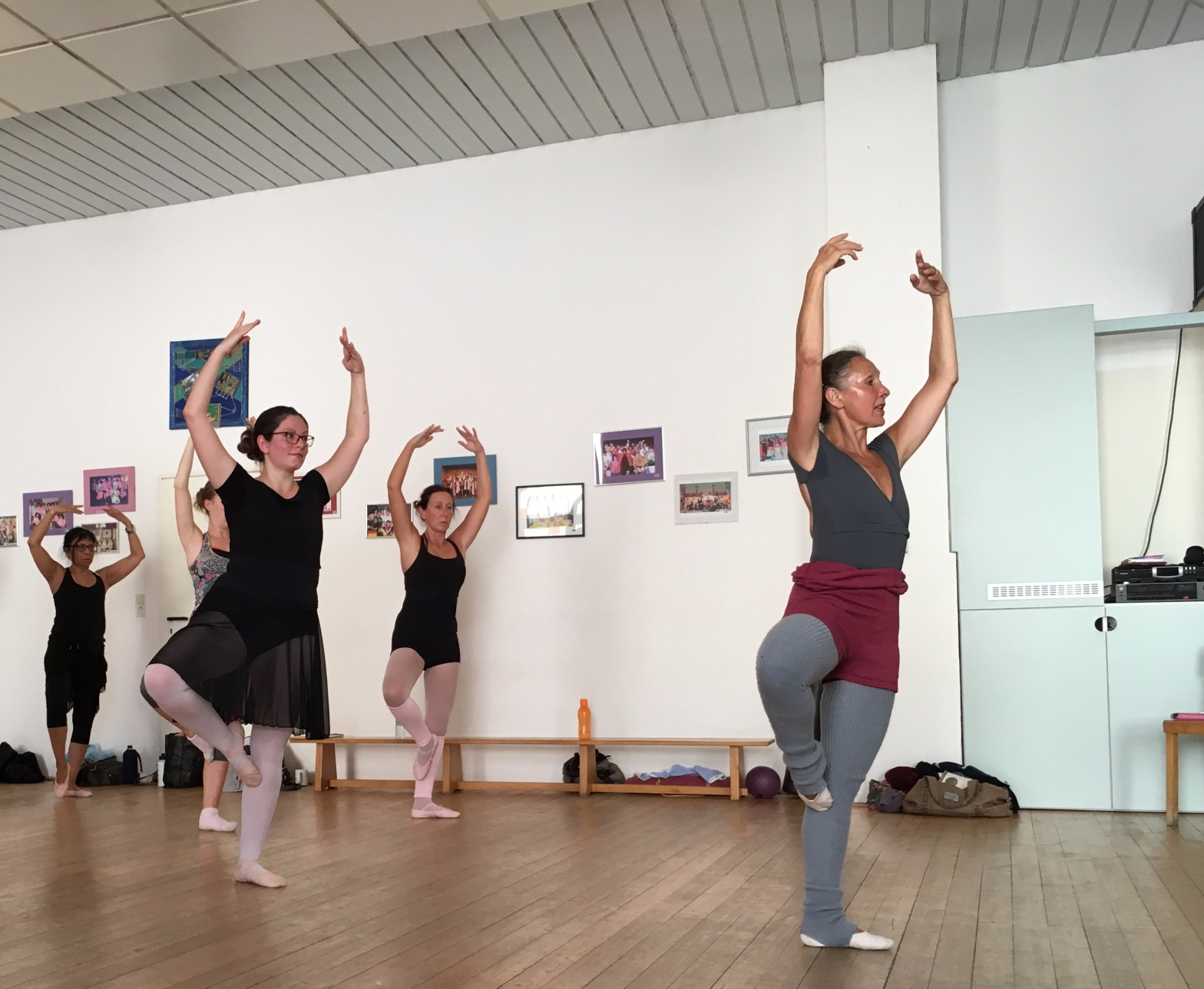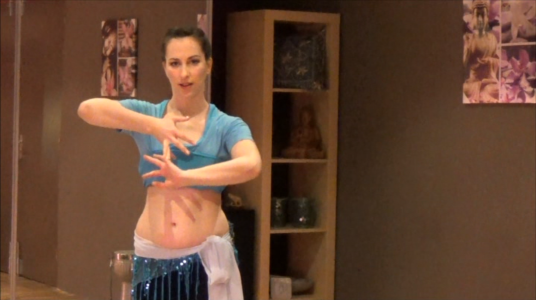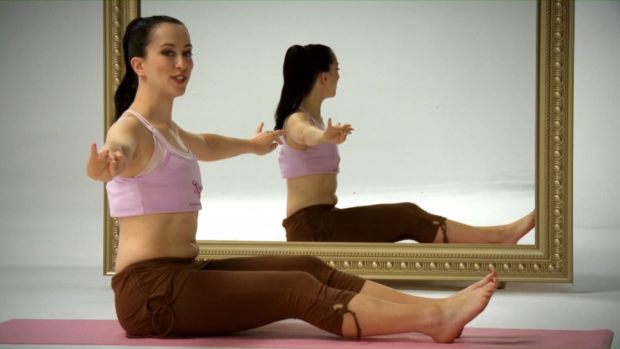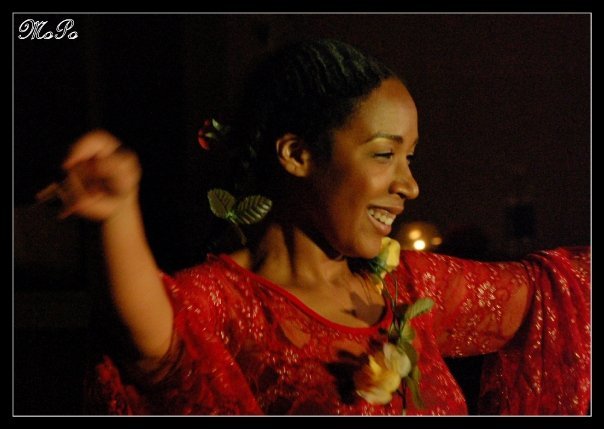Months ago, I decided my end-of-summer treat would be a weekend of workshops at Khalida’s studio called Movespiration. I knew Khalida a bit, through her DVDs and from online conversations. I’d reviewed her Shimmies DVD and worked a bit with her All About Arms program, and over email we geeked out a bit on dance and movement. So when she said she wanted to bring her favorite movement teachers into her studio for two days, I thought it would be worth going along for the experiment.
I also liked the idea of easing into bellydance by trying it again along with other dance and movement forms. And frankly, after so much stress this year, I thought it might be great just to focus on my body, no matter what the practice was. These were my two goals for the weekend.
What I knew was that we would do some taekwondo with Master Chae Seung-Eun, ballet with Constanze Janssen, and bellydance with Khalida. In fact, the two days I spent in Würselen were even more varied. Master Chae is also an expert in Haidong Gumdo, Korean sword fighting, and one of our classes with him was devoted to this art. Constanze did ballet barre exercises and centre work, but she also led us through a modern-inspired floor barre.
Sandra van Frankfoort-Mamentu, who was in the workshop as a participant, took the lead on Sunday morning and led us through a tai-chi warmup. Even Khalida’s own classes were varied: we did do a bit of bellydance movement and technique, but Khalida also introduced us to a wealth of exercises and body techniques: lymphatic drainage, tricks to improve alignment or release certain muscles, practices for increasing turnout and flexibility and reducing pain. (She taught us so many things, in fact, that at one point I had to sit down after a session and just write them all down as fast as I could.)
My biggest surprise of the weekend was how much I enjoyed the martial arts we practiced with Master Chae. Now, I’m not a very high energy person, nor do I think of myself as particularly strong, so I was a bit nervous about what taekwondo would be like. The exercises we did were exhausting, but in the best possible way. I found, to my surprise, that I loved punching and kicking. I had the good fortune to work with a partner (Lou of Brussels) who practices taekwondo, and she pushed me hard. It was wonderful. With every kick and punch I felt I was getting some of the year’s stress out, felt like I was cleansing myself of negative emotion and frustration. And at the end, although I was sweaty and had pushed myself to the limits of my energy, I actually felt revitalized.
The same was true for haidong gumdo, which we practiced using foam-covered swords for the most part, and blunt wooden swords for cutting paper. This required more precision and speed than I could muster, but also had that element of force. It felt like something I desperately want to do again. Later, as I was telling Master Chae how therapeutic I found it, he said calmly, “It looked like you had some things to get out.”

Ballet was a learning experience too, though in another way. I’ve been taking beginner ballet classes for a couple of years now, and figured I knew the basics. In Constanze’s class, I found so much to improve just in my posture and pliés that I was sweating from the first minutes. It was such difficult work (even keeping my stomach in is still a challenge), but so important in terms of how it felt to work with that strength. My balance and turns are still terrible, and I think part of that is that I’m still not pulling my muscles in the way I need to to rice up out of my legs. On the other hand, floor barre, while challenging, was a lovely release, with lots of stretching and flowing movement.
It will take a number of weeks to work through what I learned during the Movespiration weekend. There are a few things though that I want to reflect on:
- Sometimes it’s great to go really far out of your comfort zone. I would never have thought that I’d enjoy taekwondo as much as I did. But not only was it great psychologically, it also felt good as movement. I wonder what it would be like to take that knowledge that I actually enjoy putting maximum energy into something and bring it to dance.
- I think it would be a fun exercise to take a similar type of move and practice it in two or different ways, switching between movement traditions. Like: doing a tai chi walk, a ballet walk, and a bellydance walk one after the other. Or alternating taekwondo kicks with grands battements. Or playing with tai chi, ballet, and bellydance arm paths.
- I love stretching programs that are intense and feel like something is really happenig, but I need to learn more about the ways smaller movements and alignment changes can affect flexibility.
- So much of what we learn in bellydance has to be drastically unlearned for ballet. I knew about legs — we practice keeping legs slightly (sometimes very) bent in bellydance, while ballet is all about the straight leg. Then there’s the stomach, which needs to be flexible for bellydance, and pulled in tight for ballet. But I was surprised to see how useful it can be to keep the glutes really tight too in ballet, which of course would be harder to do in bellydance. I’m not sure if there’s a good solution to switching, other than consciously practicing both.
- It might be worth incorporating some journaling into dance: thinking more clearly about what I want out of any given class or practice session, and articulating for myself what kinds of things I want out of the dance itself.
This is where I am right now. I took this week to rest and let things settle — and have a bit of fun — but tomorrow I return to ballet. I’m curious to see how what I learned affects my approach, and eager to start experimenting with some of the adjustments I learned in class. I’d also love to do more taekwondo. I’m not sure I have time for another regular commitment, but I’ll see if there are any introductory lessons close to me.
And what I will definitely try to do is attend Movespiration again. Given how much we did and learned, it was an incredible value. The variety of practices we tried out took so much concentration that it felt like a real mental vacation from daily life — and that was just what I needed.

















 The two things you need to know about these lessons are: they are very well taught, and they are pretty hard to do. Any single tutorial is more than enough for a day’s dedicated work. And although Claudina has a slender figure, I realised she must have an enormous amount of strength to handle so many different kinds of veils with such grace and power. I managed to do quite a lot of the DVD, but I realised at one point that my shoulders wouldn’t be happy with me if I pushed myself any further. I need to get better at single veil first, and develop some arm strength. However, if you are willing to take it more slowly than I was, and really work with each tutorial, the sections themselves are really taught thoroughly and from the ground up, and because of the chaptering, should be easy to practice. I also loved the idea of using different kinds of props to practice before actually handling the veil, and am now wondering where I can get those long strips of silk.
The two things you need to know about these lessons are: they are very well taught, and they are pretty hard to do. Any single tutorial is more than enough for a day’s dedicated work. And although Claudina has a slender figure, I realised she must have an enormous amount of strength to handle so many different kinds of veils with such grace and power. I managed to do quite a lot of the DVD, but I realised at one point that my shoulders wouldn’t be happy with me if I pushed myself any further. I need to get better at single veil first, and develop some arm strength. However, if you are willing to take it more slowly than I was, and really work with each tutorial, the sections themselves are really taught thoroughly and from the ground up, and because of the chaptering, should be easy to practice. I also loved the idea of using different kinds of props to practice before actually handling the veil, and am now wondering where I can get those long strips of silk.

